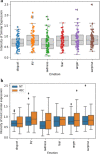Imitation and recognition of facial emotions in autism: a computer vision approach
- PMID: 33823922
- PMCID: PMC8025560
- DOI: 10.1186/s13229-021-00430-0
Imitation and recognition of facial emotions in autism: a computer vision approach
Abstract
Background: Imitation of facial expressions plays an important role in social functioning. However, little is known about the quality of facial imitation in individuals with autism and its relationship with defining difficulties in emotion recognition.
Methods: We investigated imitation and recognition of facial expressions in 37 individuals with autism spectrum conditions and 43 neurotypical controls. Using a novel computer-based face analysis, we measured instructed imitation of facial emotional expressions and related it to emotion recognition abilities.
Results: Individuals with autism imitated facial expressions if instructed to do so, but their imitation was both slower and less precise than that of neurotypical individuals. In both groups, a more precise imitation scaled positively with participants' accuracy of emotion recognition.
Limitations: Given the study's focus on adults with autism without intellectual impairment, it is unclear whether the results generalize to children with autism or individuals with intellectual disability. Further, the new automated facial analysis, despite being less intrusive than electromyography, might be less sensitive.
Conclusions: Group differences in emotion recognition, imitation and their interrelationships highlight potential for treatment of social interaction problems in individuals with autism.
Keywords: Autism; Automated analysis; Emotion recognition; Facial expression; Imitation.
Conflict of interest statement
The authors declare that they have no competing interests.
Figures







Similar articles
-
Dynamic Emotion Recognition and Expression Imitation in Neurotypical Adults and Their Associations with Autistic Traits.Sensors (Basel). 2024 Dec 19;24(24):8133. doi: 10.3390/s24248133. Sensors (Basel). 2024. PMID: 39771868 Free PMC article.
-
Differential responses in the mirror neuron system during imitation of individual emotional facial expressions and association with autistic traits.Neuroimage. 2023 Aug 15;277:120263. doi: 10.1016/j.neuroimage.2023.120263. Epub 2023 Jul 1. Neuroimage. 2023. PMID: 37399932
-
Slowing down presentation of facial movements and vocal sounds enhances facial expression recognition and induces facial-vocal imitation in children with autism.J Autism Dev Disord. 2007 Sep;37(8):1469-84. doi: 10.1007/s10803-006-0223-x. Epub 2006 Oct 7. J Autism Dev Disord. 2007. PMID: 17029018
-
Facial Expression Production and Recognition in Autism Spectrum Disorders: A Shifting Landscape.Psychiatr Clin North Am. 2021 Mar;44(1):125-139. doi: 10.1016/j.psc.2020.11.010. Psychiatr Clin North Am. 2021. PMID: 33526234 Review.
-
Facial Expression Production and Recognition in Autism Spectrum Disorders: A Shifting Landscape.Child Adolesc Psychiatr Clin N Am. 2020 Jul;29(3):557-571. doi: 10.1016/j.chc.2020.02.006. Epub 2020 Apr 9. Child Adolesc Psychiatr Clin N Am. 2020. PMID: 32471602 Review.
Cited by
-
Dynamic Emotion Recognition and Expression Imitation in Neurotypical Adults and Their Associations with Autistic Traits.Sensors (Basel). 2024 Dec 19;24(24):8133. doi: 10.3390/s24248133. Sensors (Basel). 2024. PMID: 39771868 Free PMC article.
-
Impact of imitation abilities on social communication in autistic children: evidence from an Early Start Denver Model intervention study.Mol Autism. 2025 Apr 4;16(1):23. doi: 10.1186/s13229-025-00656-2. Mol Autism. 2025. PMID: 40186296 Free PMC article.
-
A Novel Head-Fixed Assay for Social Touch in Mice Uncovers Aversive Responses in Two Autism Models.J Neurosci. 2023 Oct 25;43(43):7158-7174. doi: 10.1523/JNEUROSCI.0226-23.2023. Epub 2023 Sep 5. J Neurosci. 2023. PMID: 37669860 Free PMC article.
-
Affective Communication for Socially Assistive Robots (SARs) for Children with Autism Spectrum Disorder: A Systematic Review.Sensors (Basel). 2021 Jul 30;21(15):5166. doi: 10.3390/s21155166. Sensors (Basel). 2021. PMID: 34372402 Free PMC article.
-
Implementation of an Intelligent Exam Supervision System Using Deep Learning Algorithms.Sensors (Basel). 2022 Aug 25;22(17):6389. doi: 10.3390/s22176389. Sensors (Basel). 2022. PMID: 36080848 Free PMC article.
References
-
- World Health Organization. International Classification of Diseases 11th Revision. 2018. http://id.who.int/icd/entity/437815624.
Publication types
MeSH terms
LinkOut - more resources
Full Text Sources
Other Literature Sources

